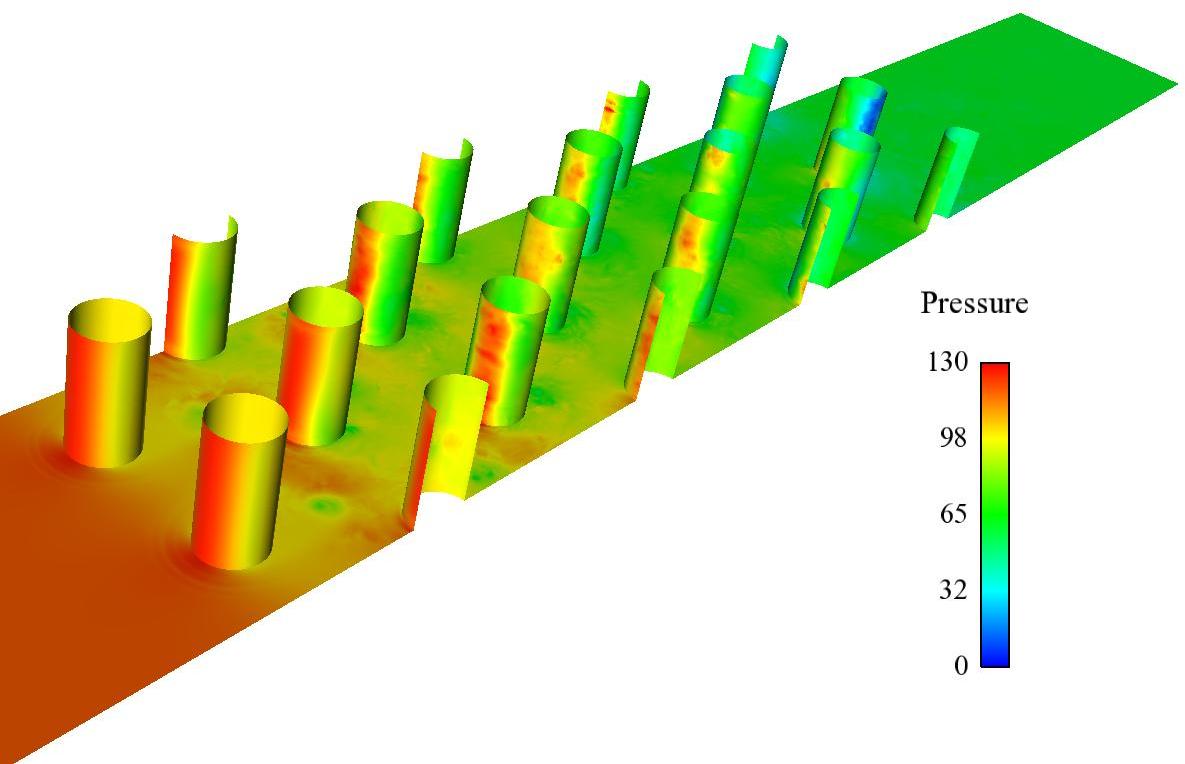Abstr:UFR 4-18
Flow and heat transfer in a pin-fin array
Confined Flows
Underlying Flow Regime 4-18
Abstract
The test-case consists in the flow through a wall bounded pin matrix in a staggered arrangement with a heated bottom wall. In addition to its interest for the complex underlying physics, this case is close to several industrial configurations for internal cooling of gas-turbine blades, electronic devices and can be also found in the nuclear field.
Objectives
Ames et al. carried out a fairly extensive experimental study for a particular configuration: the incompressible flow through a confined staggered pin fin array with a pitch to diameter ratio of 2.5, at three Reynolds numbers (3000, 10000, 30000) and with a heated bottom wall in the forced convection regime (Ames et al. 2004, 2006, 2007 and 2008).
and computationally by means of LES (Large Eddy Simulation) and URANS (Unsteady Reynolds Averaged Navier Stokes). Figures 1 to 3 show instantaneous variables in order to illustrate the complexity of the flow.
This configuration has been chosen as a test-case in the framework of the 15th ERCOFTAC-SIG15/IAHR Workshop on “Refined Turbulence Modelling” organized by the ERCOFTAC Special Interest Group on Turbulence Modelling (SIG15). This workshop took place at EDF Lab Chatou (France) in 2011.
results of the computational studies were analysed along with the experimental reference database
The challenging objective is to predict the right Nusselt number distribution on the the bottom wall.
Mainly EDF R&D has contributed calculations of the test case to the workshop with various models (LES,
URANS)
- These calculations presented here and compared with the Ames et al experimental results. Some observations from pre-workshop calculations of Delibra et al are also included. - of primary interest is Nusselt number distribution on bottom wall, but mean-velocity, turbulence quantities and pressure drop also of interest and presented and compared. - best practice guidelines given for computing the test case considered with maximum confidence.
The primary objectives of the present contribution is twofold:
- to compare two kind of turbulence approaches (wall resolved LES and wall resolved URANS using two Linear Eddy Viscosity Models and one Reynolds Stress Model)
- give Best Practice Guidelines to compute the present test-case with a maximum confidence.

Figure 1: Intantaneous view of the pressure field on the pins and the bottom wall (LES, M76, Re=10000)

Figure 2: Intantaneous view of the stream-wise velocity field (LES, M76, Re=10000)

Figure 3: Intantaneous view of the temperature field (LES, M76, Re=10000, imposed heat flux)
Contributed by: Sofiane Benhamadouche — EDF
© copyright ERCOFTAC 2024
